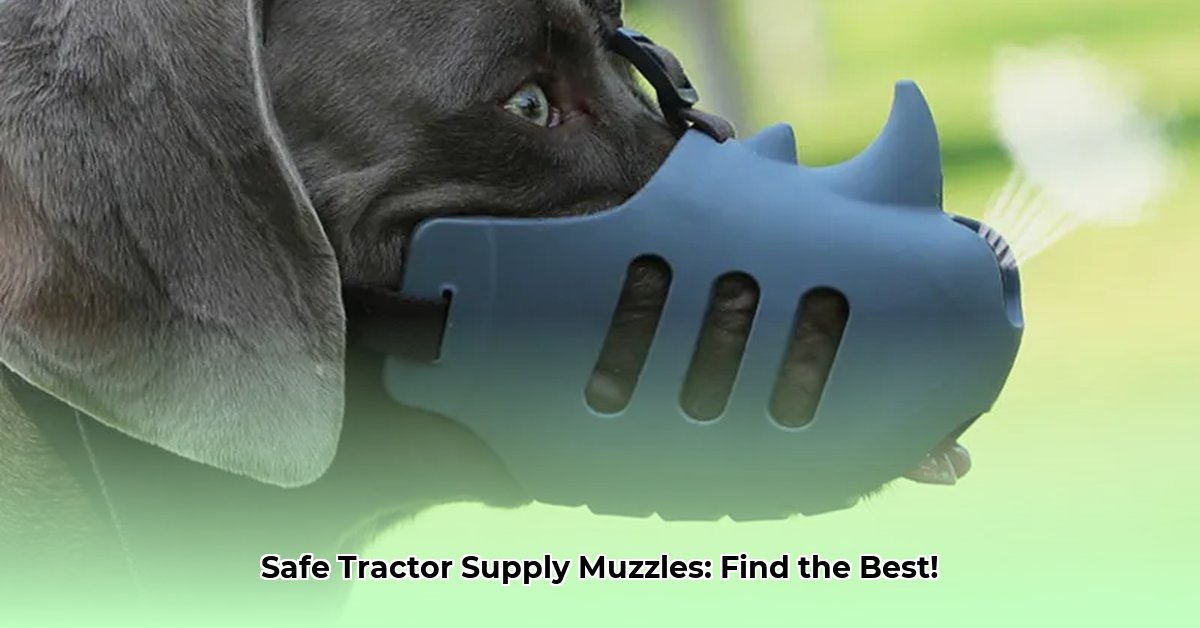
Finding the right muzzle for your dog can feel daunting, but it's a crucial step in ensuring both their safety and well-being. This guide focuses on Tractor Supply muzzles, offering expert advice on selection, fitting, and safe usage. We'll address common concerns and misconceptions, empowering you to make informed decisions for your canine companion. For more information on Tractor Supply's muzzle selection, check out this helpful resource.
Understanding Tractor Supply Muzzle Options
Tractor Supply provides various muzzle types, each with unique features and applications. The ideal choice depends on your dog's breed, size, temperament, and the intended purpose (vet visits, training, or managing behavioral issues).
Types of Muzzles: A Detailed Comparison
Basket Muzzles: These breathable, often wire or mesh, muzzles allow for panting, drinking, and sometimes even treat-taking. However, they might be bulky and less suitable for dogs with short snouts (brachycephalic breeds). They offer good ventilation and are generally considered the safest option for longer durations.
Soft Muzzles: Fabric or nylon constructions offer greater comfort, making them suitable for shorter periods. However, they provide less bite protection than basket muzzles and may not be ideal for dogs prone to chewing or escaping restraints.
Fabric Muzzles: Lightweight and often breathable, these are suitable for warm weather and short durations. They are less protective and durable compared to other options.
Padded Muzzles: Offering increased comfort with added cushioning, these muzzles can reduce chafing, potentially ideal for longer wear. However, they may be less breathable and heavier than other designs.
Here's a summarized comparison:
| Muzzle Type | Pros | Cons | Best Use Cases |
|---|---|---|---|
| Basket Muzzle | Breathable; allows panting and drinking; durable | Potentially bulky; may not fit all breeds; some dogs may resist initially | Vet visits, training, public walks |
| Soft Muzzle | Comfortable; easy to adjust; generally lightweight | Less secure; less durable; might restrict breathing in some designs | Short training sessions, calm dogs; vet visits (shorter duration) |
| Fabric Muzzle | Lightweight; breathable; less noticeable | Offers minimal protection; may not be durable | Short-term use; calm dogs; warm weather conditions |
| Padded Muzzle | Added comfort; prevents chafing; good for extended use | Heavier; may be less breathable; not suitable for all dogs | Longer outings; dogs prone to chafing |
Proper Muzzle Fitting: A Step-by-Step Guide
Improper fitting can lead to discomfort or injury. Follow these steps meticulously:
Accurate Measurements: Before purchasing, measure your dog's muzzle using a flexible tape measure. Consult the manufacturer's sizing chart for specific instructions. This is crucial for a safe and comfortable fit.
Gentle Introduction: Allow your dog to investigate the muzzle initially. Positive reinforcement with treats and praise is key to building a positive association.
Secure Fitting: Place the muzzle gently on your dog's snout, ensuring a snug but not constricting fit. They should be able to pant, drink water, and open their mouth slightly.
Supervision and Monitoring: Always supervise your dog while wearing a muzzle. Regularly check for any signs of discomfort (excessive panting, pawing, whining). Remove it immediately if needed. This is critical to avoid injury or stress.
Addressing Common Muzzle Concerns
Many misconceptions surround muzzles. Proper use prioritizes your dog's well-being.
Breathing Restriction: Properly designed muzzles allow for normal breathing and panting. Choose models designed for airflow.
Stress and Anxiety: Gradual introduction and positive reinforcement are vital to minimize anxiety. Never force your dog to wear a muzzle.
Aggression Only: Muzzles are useful for various situations—vet visits, grooming, training, or managing unpredictable behaviors in public spaces. They're not solely for aggressive dogs.
Acceptance Challenges: If your dog resists, patience and positive reinforcement are essential. Consider professional dog training assistance if needed. Consult with your veterinarian for personalized guidance.
Choosing the Right Muzzle for Breed and Behavior
Breed and temperament influence muzzle selection. A Great Dane requires a different muzzle than a Chihuahua. Consider your dog's specific needs and the intended purpose of the muzzle for optimized safety and comfort. Always prioritize their well-being.
Key Takeaways:
- Breed, size, and temperament dictate muzzle choice.
- Each muzzle type offers unique benefits and limitations.
- Proper fitting is paramount for comfort and safety.
- Positive reinforcement training is crucial for successful muzzle use.
- Always prioritize your dog's comfort and well-being. Consult your veterinarian or a certified dog trainer for personalized advice.